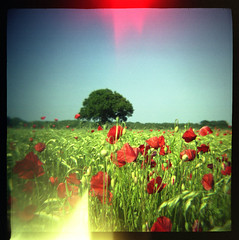I have learned some things since I was twelve and could not remove my eyes from the face of John McCrae.
For One, the internet provides a background absent from my volumes of the World Book Encyclopedia.
So first, let me share this info.
On May 2, 1915, in the second week of the Second Battle of Ypres- the battle where poisonous gas was first used - Lieutenant Alexis Helmer was killed by a German artillery shell burst. He was a friend and former student of a Canadian doctor, Major John McCrae.
Helmer was buried in the little cemetery outside McCrae's dressing station, and in the absence of the chaplain, McCrae performed the funeral. The next day, sitting on the back of an ambulance parked near the dressing station McCrae composed a poem. In the cemetery, he could see the poppies that sprang up in the ditches. He spent some twenty minutes scribbling in a notebook, watched by a young soldier by the name of Allinson, who was delivering mail that day.
"His face was very tired but calm as we wrote.
"He looked around from time to time, his eyes straying to Helmer's grave."
When McCrae finished, he took his mail from Allinson, and without a word handed his pad to him.
"The poem was exactly an exact description of the scene in front of us both. He used the word blow in that line because the poppies actually were being blown that morning by a gentle east wind. It never occurred to me at that time that it would ever be published. It seemed to me just an exact description of the scene."
…Just an exact description… No story, just what is.
It’s as if McCrae wrote from the clear consciousness that Byron Katie teaches:
the event stripped of story.
Simply the Truth.
That’s what is True.
And in this case it created one of the most powerful war poems ever written.
Thursday, August 09, 2007
Subscribe to:
Post Comments (Atom)


No comments:
Post a Comment